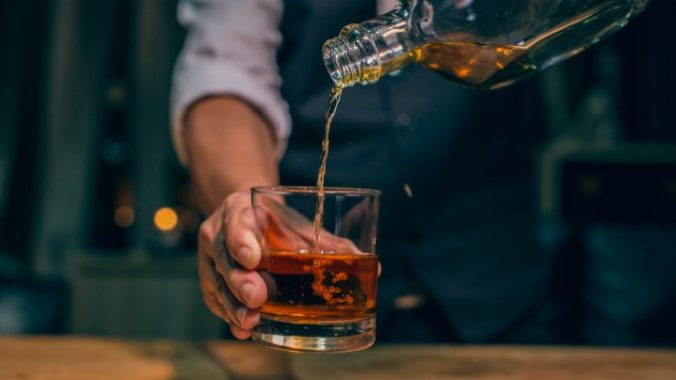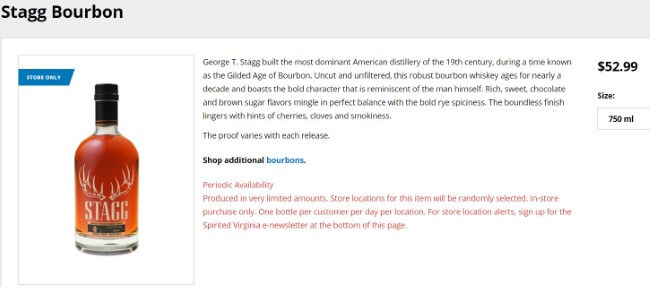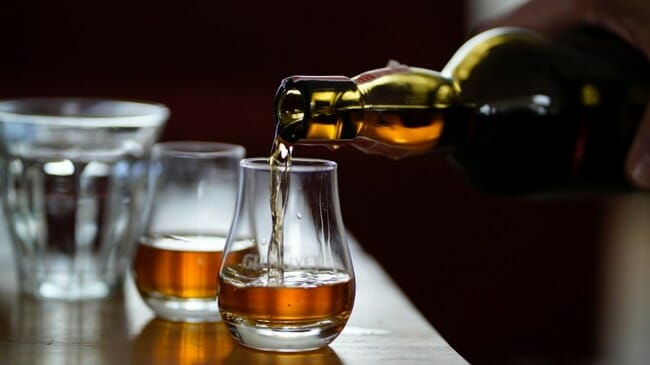Bourbon Price Gouging at Bars Is Getting Truly Ridiculous
Photos via Shutterstock, L.O.N Dslr Camera
A few years ago, after observing the frustration of American whiskey geeks–and when I say that, I clearly mean “bourbon collectors”–reaching critical mass in response to rapidly rising costs in the liquor aisle, I wrote what would end up being one of my most frequently referenced essays: This in-depth treatise on retailer price gouging. At the time, the goal was to draw attention to the fact that runaway bourbon hype and consumer desperation for anything with the perception of “rarity” had led to a migration of “secondary” market pricing from where it previously existed–between collectors trading and selling bottles to each other–onto package store shelves instead, as store owners unsurprisingly asked why they shouldn’t be the ones making 500% mark-ups from MSRP on desired bottles, rather than collectors. When I wrote that piece in 2020, retailer price gouging was a phenomenon that was just in the process of becoming standardized, and both myself and the other whiskey experts I interviewed warned that the only real way to confront this kind of gouging would be consumers refusing to purchase heavily marked up bottles.
Suffice to say, as we turn the page into 2024, things have only gotten that much worse. This kind of price gouging has gone from something novel or outrageous, into something widely expected in any market that doesn’t have state-run liquor stores enforcing specific MSRPs. By no means did bourbon collectors refuse to pay this kind of pricing: Instead, they capitulated and made so many of these sought-after brands much harder to find at MSRP than ever. To many collectors, that’s just the cost of having row after row of unopened W.L. Weller bottles on your bar for your friends to gawk at.
Entering 2024, though, what’s really catching my eye lately is a trickle-down aspect of bourbon mania and the price-gouging phenomenon. I am of course talking about the way this kind of outlandish pricing has inexorably made its way into whiskey pricing of neat pours at bars and restaurants. Particularly in states that have government-run monopoly liquor stores–that’s 17 U.S. states, currently–the desperation of bourbon drinkers has led to bars and restaurants realizing they can gouge whiskey prices to absurd, stratospheric degrees, creating comical profit margins in the process. And once again, it’s a practice that will only continue or get that much worse unless consumers refuse to play along.
But don’t just take my word for it; allow me to illustrate with an in-depth example of exactly what kind of gouging we’re talking about here.
The Math Behind A $55 Pour of Stagg Jr.
Here’s the thing about this kind of bourbon price gouging at bars and restaurants: It’s consistently inconsistent. Rarely do the prices that are set follow any kind of unifying logic, because they’re a response in the first place to an illogical level of demand created by hype and FOMO that has grown to unhealthy degrees. In a healthy hobby, people don’t demand the right to be gouged 1,000% of the list price for the ability to buy a product. But if hype gets out of control to the right degree, all bounds of logic or even traditional restaurant/bar operating procedure fly out the window. Couple that with bar managers or restaurant owners who don’t necessarily understand that product very well, and you end up with whiskey menus where the pricing feels particularly random, often reflecting nothing more than “whatever we think you’ll pay.” You’ll see this inconsistency in real time, as a product with an MSRP of $100 will be priced lower than one with an MSRP of $50, leaving the consumer unable to determine what criteria, if any, are being used to set prices.
In most states, sky-high bourbon pricing at bars and restaurants could at least be written off on some level to those businesses not necessarily being able to acquire their bottles for increasingly meaningless MSRPs. But in states like Virginia, where I reside, we can say with absolute certainty that local bars and restaurants are able to buy spirits directly from the state-operated Virginia ABC at MSRP, arguably giving those bars and restaurants an innate advantage when it comes to hotly desired spirits. This gives those businesses an incentive to then sell those spirits at secondary market prices, resulting in extreme, bloated profit margins.
This is hardly some new phenomenon, but it’s one I now witness far more often than I did a few years ago. And it all came to a head for me last week, when a restaurant whiskey menu posted in a local bourbon collecting Facebook group contained the following price point: $55 for 1 oz of Buffalo Trace’s Stagg Jr. Bourbon.

An excerpt of the offending whiskey menu.
I’m not going to shame the specific restaurant in question, but suffice to say it’s a mid-sized chain of bar and grills with more than a dozen locations in Virginia and beyond. It’s the kind of place you’d hit for affordable happy hour tacos and beer, but they’re also quite happy to make absurd profit margins by gouging bourbon in particular to the moon and beyond. That’s one of the ironic aspects that often crops up in bar/restaurant bourbon price gouging: These same places are often offering otherwise solid values across most of their food and drink menus, because that’s what their customers expect/demand. They’ve just zeroed in within the last few years on one inescapable revelation that has no doubt been helping to prop up the bottom line: Bourbon geeks are desperate, and they will pay anything you demand of them. This applies almost exclusively to neat whiskey pours, as many of these places maintain more reasonable or logical pricing even on bourbon-centric cocktails. They simply know that the desperate bourbon collectors are out there, and know that they’ll pay insane prices sooner or later.
But even by those standards, $55 for a 1 oz pour of Stagg Jr. is especially egregious, though still all too common in this day and age. And it’s really not until you dive into all the economic facets of what this pour logically should cost that the degree of gouging really becomes clear.
So let’s start with the following: Stagg Jr. (now just labeled as “Stagg”) is a cask-strength, moderately aged bourbon from Buffalo Trace, which means like most any other BT bourbon, it’s widely gouged to significantly higher levels ($200-300) at many package stores. In Virginia, however, it’s available for a very friendly $53 at every single Virginia ABC store when it’s in stock. Obviously, this results in every arrival of Stagg Jr. instantly selling out when it arrives. It also means that we know the restaurant can acquire its Stagg Jr. from the state for $53 per bottle.
Each 750 ml bottle of Stagg Jr. contains 25.36 fluid ounces. If the restaurant is charging $55 for each particularly small 1 oz pour, that works out to roughly $1,395 worth of revenue inside every Stagg Jr. bottle. Which is to say, the restaurant has an extreme incentive to acquire as many of these bottles as they can, because they represent such a crazy potential profit margin.

All official liquor purchases for Virginia bars/restaurants go through the Virginia ABC, although you do hear a few things to the contrary from time to time…
Successful bar operators and bar/restaurant consultants will tell you that the gold standard for profit margin in successful bars, when it comes to alcohol, tends to be about 80%. This means that for any bottle of liquor, the “pour cost” is likely to be around 20%, i.e. in each serving/pour from that bottle, 20% of the price paid by the consumer reflects the cost of the bottle and 80% is profit margin. For example: A bottle of liquor that costs a bar $20 contains 16.9 servings at 1.5 oz, the standard size of a shot glass. That means each serving costs the bar roughly $1.18. Final cost to the consumer for that shot would therefore mathematically work out to $5.91 in order to have a 20% pour cost and 80% profit margin. Round up to an even $6 and you’re making a tidy, industry standard profit on a typical bottle of liquor.
With something like the Stagg Jr., though, every bit of industry standard immediately goes flying out the window in the face of pure, unmitigated greed. First, the restaurant squeezes the serving size down to 1 oz rather than 1.5 oz, meaning they can now get 25.36 servings out of every bottle. At the $53 that the restaurant pays for the bottle of Stagg Jr. from the Virginia ABC, this means each 1 oz serving costs the bar $2.17 to pour. If they were operating with a 20% pour cost and 80% profit margin–once again, the industry standard–this would work out to charging the customer $10.85 for that 1 oz pour of Stagg Jr.
Let’s give the restaurant the benefit of the doubt, though, because bars often try to make more profit on “super premium” bottles by putting them in the 15% pour cost range. This would require the bar to price Stagg Jr. at roughly $14.47 per 1 oz pour. It’s still just a tiny fraction of the $55 they’re actually charging for each 1 oz pour.
The actual price this bar is charging works out to a pour cost of just about 4%, in reality. Which is to say: Of each 1 oz serving they sell of Stagg Jr. for $55, only 4% of that reflects the cost of the bottle, leaving a 96% profit margin. They’re charging more for a single oz of that whiskey than they’re paying for the entire bottle, leaving an additional 24.36 servings of profit in every bottle.
Suffice to say, there’s no other corner of the alcohol world where a restaurant or bar can come even close to getting away with this kind of price gouging. Bourbon has become a special case, because it’s the only field where the enthusiasts are so desperate to say they’ve tasted something–so eager to snap a photo and share it for status and clout among their online brotherhood–that they’re willing to rationalize away the gouging and tacitly agree to let it continue.
If You Hate Bourbon Price Gouging, Don’t Participate in It

At the end of the day, it’s as simple as the header above: This kind of bar and restaurant price gouging will inevitably continue for as long as consumers signal they’re willing to keep paying these prices. As much as we might like to blame the greed of bar or restaurant operators for this kind of predatory pricing, it’s an inevitable economic outcome of consumers who are so willing to fork over the entire contents of their wallet for an ounce or two of whiskey. I can only imagine that for many of these businesses, being able to gouge the local whiskey geeks has likewise been a lifeline during an otherwise deeply challenging post-pandemic dining era. You can hardly blame them, when the customer is still clamoring for more.
It should go without saying that the objective experience of the bourbon you’re hunting will never be able to justify this kind of gouging, unless you’ve dug yourself into a hole of needing to rationalize this kind of spending to yourself, or your partner, in order to avoid feeling like you’ve been duped. Might I take this opportunity to suggest, as I have so many other times before, that this is a perfect moment to diversify the kinds of spirits you’re drinking? There’s never been a more exciting variety of (high value) other spirits available, from rum, malt whiskey and tequila to gin, brandy or emerging fields like amaro or sotol. There’s never been a better time, likewise, to develop an appreciation for high-quality cocktails, or realize how truly easy and rewarding it is to make them at home. There are incredible values to be had, if you’re willing to ignore groupthink for a moment and stop believing internet whiskey groups when they tell you that only limited edition bourbon is worth your time and money.
This is understandably not what most bourbon geeks want to hear, as it runs counter to the status-obsessive world of whiskey collecting that is disseminated through social media in particular. When you constantly see people sharing Facebook photos of their bottle collections and high-roller pours at bars and restaurants, it creates a desire to match those hedonistic experiences and the admiration/envy they generate. This in turns helps consumers to rationalize being gouged, figuring that at least they’re in good company, but it only encourages more gouging in the end.
Ultimately, the consumer is the only one who has a direct lever to affect any change. When you see pricing like this in a bar or restaurant, don’t entertain it. Call it out to ownership, as politely as you’re able to do so. Encourage your friends and internet strangers not to buy at these kinds of prices, rather than enviously pushing themselves to match the performative spending they see online every day. Expand your horizons instead, and enjoy a diverse and delicious world beyond simply bourbon, while continuing to reward those restaurants/bars that do operate with fairer whiskey pricing. If enough of us can take these maxims to heart, perhaps none of us will ever have to see a bar and grill charging $55 for an ounce of Stagg Jr. again.
Jim Vorel is a Paste staff writer and resident craft beer and spirits geek. You can follow him on Twitter for more drink writing.







































